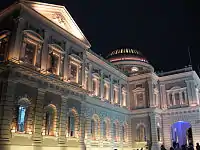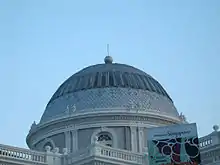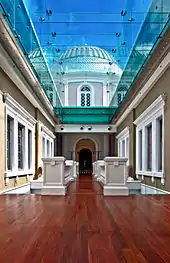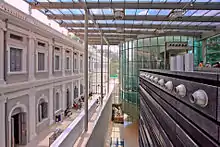National Museum of Singapore
The National Museum of Singapore is a museum in Singapore dedicated to the history of Singapore. It is the oldest museum in Singapore, with its history dating back to 1849, when it was started as a section of a library at Singapore Institution and called the Raffles Library and Museum. After several relocations, in 1887 it moved to its permanent site at Stamford Road in the Museum Planning Area. Between 1993 and March 2006, it was known as the Singapore History Museum; it was given its present name in 1965.
| National Museum of Singapore | |
|---|---|
.jpg.webp) | |
| Location | 93 Stamford Road, Singapore 178897 |
| Coordinates | 1°17′48.2″N 103°50′55.1″E |
| Built | 1849 |
| Architectural style(s) | Neo-Palladian, Renaissance |
| Governing body | National Heritage Board |
| Website | nationalmuseum.sg |
| Designated | 14 February 1992 |
.svg.png.webp) Location of National Museum of Singapore in Singapore | |
The National Museum of Singapore underwent a three-and-a-half-year restoration and reopened on 2 December 2006, with the official reopening by former President of Singapore S. R. Nathan and the Minister for Information, Communications and the Arts taking place on 7 December 2006.[1] The Singapore History Gallery opened on 8 December of the same year.
It is one of four national museums in the country, the other three being the two Asian Civilisations Museums at Empress Place Building and Old Tao Nan School, and the Singapore Art Museum.
History

The museum was established in 1849 by the then Singapore Institution Committee. It was called the Raffles Library and Museum and exhibited items of historical and archaeological value from Singapore and elsewhere in Asia. The museum was part of an establishment of a public repository of knowledge of Malayan in a school, museum and library. This objective can be traced to an 1823 meeting called by Sir Stamford Raffles to discuss a revival of the region's cultural heritage. The museum occupied a section of the library of the Singapore Institution, later became the Raffles Institution. In 1874, the museum moved to the Town Hall (now known as the Victoria Theatre and Concert Hall). However, due to the growing collection in the museum, it moved back to the Singapore Institution in 1876 situated at the new wing of the institution.
The Raffles Library and Museum later moved to Stamford Road in a new building that was commissioned by the colonial government in 1882. The museum was officially opened on 12 October 1887 which also marked the Golden Jubilee of Queen Victoria. The library was referred to by the locals in Malay as Rumah Kitab (house of books) or Tempat Kitab (place of books). The museum was designed by Sir Henry McCallum but a scaled down version was used as the Colonial Office rejected the initial proposal, Major J.F. McNair co-designed the later version.
In its early years, the museum was well known for its zoological and ethnographic collections of Southeast Asia especially Malaya and British Borneo before the World War II. The museum was a centre of research and knowledge, directors and curators were by and specialists of good research accomplishments including zoologists Richard Hanitsch, John Moulton, Cecil Boden Kloss, Frederick Chasen and anthropologists HD Collings and Gibson-Hill who were also interested in ornithology, Malay history, ethnography and photography. The museum was the seat of the editorial office of the Journal of the Malayan Branch of the Royal Asiatic Society, it was visited by scholars who were en route to their trips to Malaya and Indonesia. The collections included a selection of northern Nias objects from the field trips of Elio Modigliani, as well as the basketwork gifted by Dr William Abbott, who collected them during the 1900s for the United States National Museum, later the Smithsonian Institution.
Extensions were carried out in 1906, 1916, 1926 and 1934 due to the inadequate space for the growing number of times ti. L and books. During the Japanese Occupation, the place was left intact by the Japanese occupying army due to the reputation of its Raffles collection and research integrity. The museum split from the library, with the latter forming the National Library adjacent to the museum building in 1960 which was demolished and relocated to Victoria Street in 2005, the former was housed in the Stamford Road building.
After Singapore's independence in 1965, the museum focused its collection to nation-building and the history of Singapore and was renamed the National Museum. Its zoological collections was moved to the biology department of the National University of Singapore and to some museums such as in Kolkata in India and Kuala Lumpur in Malaysia. This all happened in 1969. Its most iconic artefact was the skeleton of a blue whale found in Port Dickson in 1893 and was displayed from 1903 to 1969. The museum then featured exhibits on history, ethnology and arts of Singapore and the region.
Hawpar Group donated a jade collection in January 1980. Restoration works of the building were carried out in 1985 which included a repainting of the building and restoring some of the distinctive features. After restoration, the museum was gazetted as a national monument on 14 February 1992. The museum came under the management of the National Heritage Board in 1993 and was renamed the Singapore History Museum becoming the flagship of the four national museums in Singapore. The building was closed in April 2003 for extension and restoration works and the museum was temporarily relocated to Riverside Point where an exhibition known as Rivertales was displayed.
Redevelopment works


The National Museum building was closed for a period of three and a half years and museum operation was temporarily located at Riverside Point. The building underwent a S$132.6 million revamp with a new annexe block behind the building on the site, which was formerly the demolished Drama Centre. Its new wing is partially built on ground hollowed out from nearby Fort Canning Hill, and a 30-metre deep diaphragm wall was built to prevent subsidence. A foundation stone ceremony was held on 25 November 2004 and it was then the museum publicly announced the name change. The structural top out ceremony was on 28 November 2005 and the new building is twice as large as the old one. The temporary museum at Riverside closed its operation on 6 March 2006 and the new museum reopened on 7 December 2006.
Poor restoration works in the 1980s cost some of its architecture features to be hidden or badly damaged. The fish scaled tiles were all taken down and cleaned, all 3,000 tiles were individually numbered to allow it to be replaced in the correct sequence. Every row of tiles was shaped differently, so as to match the curves of the dome. Badly restored tiles were removed and new replaced tiles were made in the original zinc material used in the old 19th century tiles made in Manchester, England. The tiles had deteriorated badly due to the effects of acid rain. A titanium-zinc-based coating was used to protect the new tiles, to prevent further oxidation and erosion.
On the building's dome, there are stained glass panels, these panels were all taken down, inspected and cleaned. These panels had deteriorated due to its age and the effects of gravity on the lead works. Each panel had to be transported in a special mould and sent to a stained glass restorer who used 18th century reinforcement techniques to restore the lead and glass works; the process took four months to complete. Modern staircases have been installed in the building to contrast the old and new. A spiral staircase which leads to the roof of the old museum building was restored. The windows and doors were conserved and the original type and size of timber and 18th century carpentry techniques were used to restore the timber windows and doors. Some of the original timber works used huge timber sections made of kapur wood. These sections required about four months to source, supply, fumigate, treat, cut and deliver to the site.
The balustrades on the second floor of the old rotunda were patterned after those in London's Royal Albert Hall. The details of the balustrades were hidden after years of paint. The old paint was removed and a special clear coat was applied to prevent rusting of the wrought iron and to allow the details to be visible. Plaster works were carried out on the plaster motifs, cornices, balustrades, capitals and carving of the old building were either deteriorated or destroyed during the earlier renovations. Skilled artisans from India were brought in to recreate the plaster works which include restoring many of the windows, doors and cornices.
Its largest work done was the coat of arms of Queen Victoria and the entire northern facade which had been destroyed. An ornate rose timber ceiling rose in the original galleries were hidden by false ceilings constructed for air-conditioning in the 1980s. The rear of the building had few windows and replicas had to be made for windows facing Fort Canning and timber wood was imported from Indonesia. A 22-metre long and 11-metre high glass connector replaced a hard ceiling for visitors to view the museum's dome from the museum itself, whereas previously, one had to view the entire dome across Stamford Road.
Architecture

National Museum was designed in Neo-Palladian and Renaissance style and consists of two rectangular parallel blocks, with a dome at the front of the building. Its architects were Henry McCallum who designed the original version and J.F. McNair who designed the scaled down version of the building. The building has two rotundas, a new glass-clad rotunda at the rear area of the building. Its glass rotunda is a cylindrical shaped building which is made up of two drums, with the outer one made of glass which sheaths an inner one made of wire mesh. Black out curtains has the same length of the inner drum with images projected on sixteen video projectors in the day. The curtains are drawn after sunset, and projection can be beamed out through the glass to get a view of the city. Coats of arms are found on the building's front.
The redeveloped building was designed by local W Architects with the glass-clad rotunda designed inspired by Chinese American I.M. Pei. The chief design consultant was Mok Wei Wei from W Architects, who was appointed in June 2004 and modified the designs of glass rotunda and the atrium between the two buildings. The new glass clad building was designed such that the old building would still be the centrepiece of the museum. A six-metre gap exists between the back of the main museum building and its new annexe as conservation guidelines do not allow old and new buildings to be directly connected. In the gallery theatre, bricks are designed in a herringbone brick pattern, which helps to control the echoes and acoustics in the space. Initially, the designers planned to use bricks from the old National Library building, but the cost was too expensive. Black concrete flooring was used for the new block instead of grey granite flooring as initially planned.
The museum will have a permanent 2,800 m² gallery space at the new glass clad building within a glass rotunda known as the Singapore History Gallery. It will feature the history of Singapore from the 14th century in a story-telling approach. Images and film can be projected on its 15-metre high cylindrical walls. There will be a narration of the history and display of artistic expressions of the history.
A ramp spiral in the new building leads down to an exhibition space holding the nation's treasures which includes the Singapore Stone and 14th century gold ornaments unearthed from nearby Fort Canning Hill in 1928. There will be a 250-seat auditorium known as The Mesh for talks, lectures and workshops for the young and old at the Fort Canning entrance. It will have retail facilities as well as a café and a restaurant at the Stamford Road block of the building. Elevators and escalators have been constructed at the museum with access for the disabled. An area will feature classrooms and outreach programmes. A vehicular entrance can be accessed by Fort Canning Road at the new building. In the basement, there is a column-free 1,200 m² exhibition gallery for temporary exhibits. It has insulated walls without windows and the space is climatically controlled to protect the exhibits from light and heat or humidity changes.
A resource centre will be housed in the building which will contain old books, photographs, negatives and stamps for public viewing. It had been fitted with Wireless@SG items.
Collection
The museum used to house a vast collection of zoological items, but were transferred to the National University of Singapore (NUS) and other museums in the Commonwealth.
It currently has eleven precious artefacts, namely the Singapore Stone, the Gold Ornaments of the Sacred Hill from East Java, Dagguerreotype of Singapore Town which was one of the earliest photographs of Singapore, the will of Munshi Abdullah, the portrait of Frank Athelstane Swettenham, the hearse of Tan Jiak Kim, a Peranakan coffin cover, the mace of the City of Singapore commemorating King George VI's raising of the island's status to a city in 1951, the Xin Sai Le puppet stage, William Farquhar's drawings of flora and fauna and the portrait of Shenton Thomas, who was the former governor of Singapore. Rocks from the nearby Fort Canning Hill were used to create two sculptures commissioned from Cultural Medallion-winner Han Sai Por.[2][3]
See also
References
- Clara Chow, "National Museum opens after $132m makeover", The Straits Times, 8 December 2006
- Lim, Wei Chean (31 January 2006). "Singapore's Treasures". The Straits Times. The other ten national treasures are: (1) a 1904 portrait of Sir Frank Athelstane Swettenham, the first Resident General of the Federated Malay States, by John Singer Sargent; (2) the last will and testament of Munshi Abdullah, the father of modern Malay literature; (3) the mace of the City of Singapore (1953) that was presented by Chinese philanthropist Loke Wan Tho in conjunction with King George VI granting Singapore a Royal Charter in 1951, raising its status to a city; (4) an 1844 daguerreotype of the view from Fort Canning Hill by French customs service officer Alphonse-Eugene Jules, one of the earliest photographic images of Singapore; (5) 14th-century gold armlets and rings in East Javanese style, found at Fort Canning Hill in 1928; (6) a 1939 portrait of Sir Shenton Thomas, the last Governor of the Straits Settlements, by painter Xu Beihong; (7) a collection of 477 natural history drawings of flora and fauna in Melaka commissioned by Resident of Singapore William Farquhar in the 19th century; (8) a wooden hearse used for the funeral of Chinese philanthropist Tan Jiak Kim in 1917; (9) an early 20th-century embroidered Chinese coffin cover, one of the largest of its kind in existence in Singapore; and (10) a glove puppet stage belonging to the Fujian puppet troupe, Xin Sai Le, which came to Singapore in the 1930s.
- "Our Top Twelve Artefacts". National Heritage Board. Archived from the original on 14 June 2007. Retrieved 17 July 2007.
Further reading
- Lenzi, Iola (2004). Museums of Southeast Asia. Singapore: Archipelago Press. ISBN 981-4068-96-9.
- National Heritage Board, Archipelago Press, Singapore's 100 Historic Places (2002), ISBN 981-4068-23-3
- Norman Edwards and Peter Keys, Times Books International (1996), Singapore: A Guide to Buildings, Streets and Places, ISBN 981-204-781-6
- "National Museum of Singapore (Singapore Biennale) 2006". Singapore Biennale. Archived from the original on 25 July 2006. Retrieved 27 July 2006.
